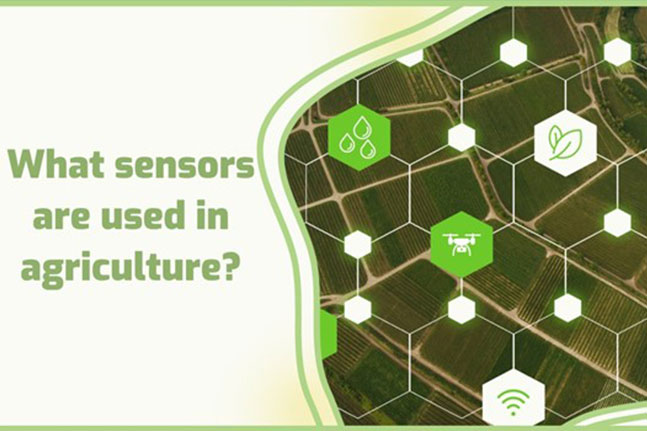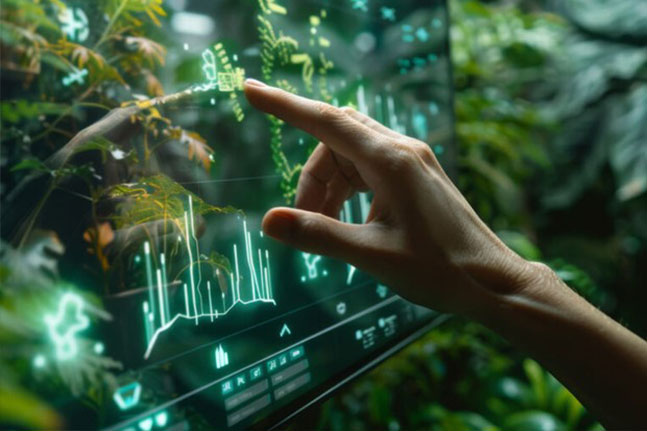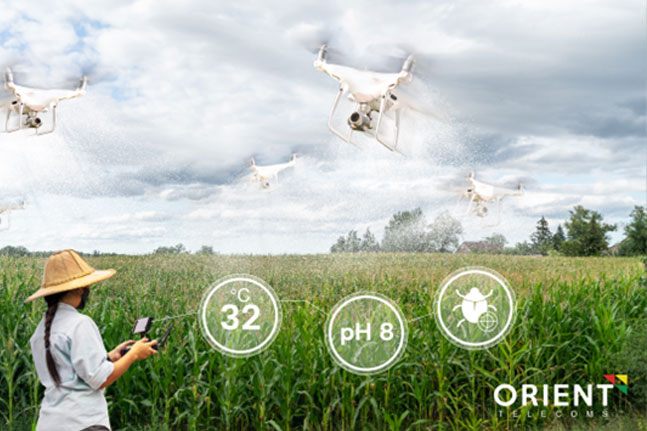
TECHNOLOGY FEEDS SUSTAINABLE AGRICULTURE
September 27, 2024
Artificial Intelligence (AI) can help building a strong Agriculture economy
November 27, 2024Due to population growth, climate change, reduced rainfall, and increasing demand for food, farming is being negatively impacted, leading to changes in cultivation methods. Therefore, to improve yields and collect accurate data, it is crucial to adopt modern and precision agricultural practices and install various types of sensors.
Given the latest situation and the negative impact on normal farming practices, agriculture needs to be carried out more intelligently, using new and state-of-the-art technology. It is the only way to provide a solution and meet the endless and growing needs of the world’s population.
Precision agriculture sensors are very efficient in agriculture because they transmit data that helps farmers not only to monitor but also to improve their products and keep abreast of changes in the field and ecosystem.
Intelligent agricultural sensors help to easily identify animals, detect heat and monitor their health, thus facilitating the isolation and healing of sick cows by identifying, detecting, and following herds.
Using smart sensors in agriculture, farmers can now record their crops and keep an eye on their effectiveness remotely, address crop pests and take swift action to protect their crops from any risk to the environment.
WHAT ARE SENSORS?
A sensor is a gadget that perceives and responds to certain inputs which could be illumination, locomotion, pressure, heat, or moisture, and transforms it into a representation or signals that can be read by humans for further reading and processing.
They are commonly used in various applications, from detecting motion in security systems to measuring temperature in HVAC systems. They are also used in everyday objects like smartphones, cars, and appliances.
Sensors work by detecting physical or chemical changes in the environment and converting them into electrical signals. The type of sensor used depends on the type of change being detected.
For example, a temperature sensor detects changes in temperature and converts them into electrical signals that can be interpreted by the device it is connected to.
WHAT ARE THE TYPES OF SENSORS USED IN AGRICULTURE?
There are various types of sensors used in agriculture that enable the need for smart agriculture incorporation.
- OPTICAL SENSORS IN AGRICULTURE
This is the use of light to evaluate soil materials and track countless light prevalence. These sensors can be positioned on automobiles, satellites, drones, or robots thereby enabling the soil to reflect and the gathering and processing of plant color data.
Optical sensors also have the ability and capacity to condition the clay, natural matter, and humidity properties of the soil.
- ELECTROCHEMICAL SENSORS FOR SOIL NUTRIENT DETECTION
The electrochemical sensors aid in the collection, processing, and mapping of the chemical data of the soil. They are usually mounted on specially designed sleds.
They supply accurate details required for agriculture. This includes the nutrient of the soil levels and pH. The soil samples are then sent out to a soil testing lab and standard procedures are carried out.
Error-free measurements especially in the area of determining pH are carried out with the use of an ion-selective electrode. These electrodes notice the pursuit of specified ions, such as hydrogen, nitrate, and potassium.
- MECHANICAL SOIL SENSORS FOR AGRICULTURE
These types of sensors are used to measure soil compression or mechanical opposition. This sensor uses an application that passes through the soil. This sensor then records the force calculated by pressure scales or load cells.
When a sensor passes through the soil, it documents the holding forces that result from the cutting, smashing, and displacing of soil. Soil mechanical resistance is recorded in a unit of pressure and points out the ratio of the force necessary to go into the soil channel to the frontal area of the tool engaged with the soil.
- DIELECTRIC SOIL MOISTURE SENSORS
This sensor calculates the moisture levels in the soil with the assistance of a dielectric constant. This is an electrical property that substitutes depending on the moisture content in the soil.
The moisture sensors are used in association with precipitation check locations all around the farm. This allows for the scrutiny of soil moisture positioning when vegetation level is low.
- LOCATION SENSORS IN AGRICULTURE
They are also known as agricultural weather stations. They are positioned at different places throughout the fields. These precision agriculture sensors are used to determine the variety, distance, and height of any position within the required area. They take the help of GPS satellites for this purpose.
- ELECTRONIC SENSORS
They are installed on tractors and other field equipment to check equipment operations. Data are transmitted via cellular and satellite communication systems to computers or mailed to individuals directly. The supervisor in charge can now have access to the information either on their office computer or their personal cell phones.
- AIRFLOW SENSORS
Its measurements can be made at particular locations while on the move. These types of sensors measure soil air penetration. The expected result is the pressure needed to push a decided amount of air into the ground at a prescribed depth. There are various soil properties, including moisture levels, soil type compaction, and structure, which produce a different identifying signature.
- AGRICULTURE SENSORS IOT
With the increase in adoption of the Internet of Things (IoT) the ability to connect various devices have being implemented in virtually every aspect of our life. It only makes great sense that automation also finds its own application in agriculture as it will have a great impact on it.
This sensor provides real-time information on what is happening on the field such information including air temperature, soil temperature at various depths, rainfall, leaf wetness, chlorophyll, wind speed, dew point temperature, wind direction, relative humidity, solar radiation, and atmospheric pressure.
This indicates that farmers are in the know-how of when their crops are due for harvest, the quantity of water being used, the soil health, and if there’s a need for any additional input. This is measured and recorded at scheduled intervals.
There is a big list of sensors used in agriculture IOT sensors which means (Solutions for Smart Farming). Making use of precision agriculture sensors will definitely transform the agricultural industry by increasing crop production, adopting a pest-free high yield variety in crops, and keeping up with the increasing demand for food.
THE MOST POPULAR TYPES OF PRECISION AGRICULTURE SENSORS
As a result of the fast-paced rise in the world’s population, farming activities have become increasingly complex, competitive, vast, and optimized.
The use of technology has led farming operations to be more productive than before thereby increasing what farmers harvest and the quality of products.
Sensors have played critical roles in this technological advancement. Below we explore key sensors in smart agriculture technology.
- GPS SENSORS
This sensor is generally associated with the automotive and cellular communication industries. They are highly advantageous to smart agriculture. One major challenge ancient settlers have had to experience is in sheep herding, having to use wooden staffs to drive their cattle.
This is because keeping track of their flocks is of ultimate importance to farmers. With the use of modern GPS, tracking livestock is no longer a challenge as this GPS is heightened with the ability to monitor the animals with a simple push of a button.
With regards to the mechanical side of agriculture, which involves plant harvesting and related farming techniques, the use of GPS sensors have being adopted with us of highly precise vehicle guidance systems.
In many farming applications, such as tilling a field, making use of auto-guided systems can enhance field routing, reduce overlapping processes and eventually reduce the quantity of time required to complete a task.
- AGRICULTURAL TEMPERATURE SENSORS
Regarding smart agriculture, temperature sensors are crucial in two key categories. These categories are ambient condition monitoring and mechanical asset monitoring.
For instance, ice wine harvesting usually occurs within a narrow temperature window when temperatures first reach between -10°C and -12°C during a harvesting season. The ice wine industry requires a highly accurate temperature and humidity sensor to give a precise prediction of the temperature forecast.
These types of sensors do not only play an important role in monitoring the ambient conditions of physical space, but they play a crucial role in virtually all smart agriculture asset monitoring applications.
- ASSET MONITORING
This is one more application in smart agriculture that makes use of temperature sensing as an evaluative role. As well as observing the plants that are being harvested, temperature sensors take note of the equipment that gathers these plants.
Whenever an equipment system is in need of minor maintenance, is underperforming, or is critically failing, the temperature sensor dishes out an alert. They are highly effective in virtually every that relates to the predictive and reactive maintenance system. This in turn protects against overheating and detrimental failure of equipment.
- ACCELEROMETER SENSOR
This is quite similar to the use of temperature sensors in maintenance prediction. Accelerometers are vastly made use of across the smart agriculture industry to predict and assist with required maintenance. They are mostly used on moving components and motors.
Their major aim is to detect slight variations in movement and vibration inconsistencies and foretell when standard maintenance is required or a compromised component needs to be replaced.
However, this sensor is usually associated with farming and other agriculture, accelerometers play an indispensable role in the maintenance of vital smart agriculture equipment. Accelerometers can also be used in various automated systems and tracking methods.
For instance, a low-power accelerometer makes it easier and faster to monitor the status of an adjustable spray nozzle on the end of a fertilization beam. With adverse technology, the use of autonomous drones in smart agriculture depends critically on accelerometers and IMU (inertial measurement units) to track motion, speed, crash events, and even position in space.
SMART CAMERAS USE IN AGRICULTURE
When it comes to smart camera technology, it is far from the old analog sensor. Smart cameras have been increasingly adopted for a variety of smart agriculture applications.
Various companies such as Blue River Technology, a division of John Deere, have adopted the use of smart camera technology to detect weeds and other plant locations.
As a result of this, an automatic and accurate dispensation of herbicides and fertilizer is carried out. This makes use of chemical utilization and increases overall productivity while decreasing chemical usage.
One of the most significant challenges in agriculture is the issue of pest control. With the use of smart cameras, farmers can now detect pests in real-time and effectively monitor actions against pests without necessarily harming helpful agricultural insects.
Smart cameras can also take the place of semi-legacy sensing devices such as ambient light monitoring, thereby enabling a simplified system and a reduction in the component count.
Precision farming is the application of specific inputs at various rates to optimize economic efficiency and reduce wastage. The use of precision agriculture sensors aids farmers makes a smooth move from the old ways of carrying out farming activities.
The importance of different types of sensors can not be over-emphasized as they help meet the demand for food, magnify yields and minimize resources.
These different types of precision agriculture sensors are easy to operate and cheaper in the long run. They make life easier for farmers and increase the overall quantity and quality of products delivered. It is advisable that every farm owner should consider smart farming.
What types of sensors are used in precision agriculture?





